
Broby bro Runestones
Encyclopedia

- Main article Jarlabanke RunestonesJarlabanke RunestonesThe Jarlabanke Runestones is the name of c. 20 runestones written in Old Norse with the Younger Futhark in 11th century, Uppland, Sweden.They were ordered in the by what appears to have been a chieftain named Jarlabanke Ingefastsson and his clan , in Täby...
At Broby bro in Uppland
Uppland
Uppland is a historical province or landskap on the eastern coast of Sweden, just north of Stockholm, the capital. It borders Södermanland, Västmanland and Gästrikland. It is also bounded by lake Mälaren and the Baltic sea...
, Sweden
Sweden
Sweden , officially the Kingdom of Sweden , is a Nordic country on the Scandinavian Peninsula in Northern Europe. Sweden borders with Norway and Finland and is connected to Denmark by a bridge-tunnel across the Öresund....
there are six runestones. U 139, U 140 and U 151 still stand by the road, but U 135, U 136 and U 137 have been moved a distance away from the road.
The last three stones are in the style Pr2 and thus dated to the period 1020-1050, but the internal relationship between them shows that U 137 is the oldest one. They belong to a group of c. 20 runestones called the Jarlabanke Runestones
Jarlabanke Runestones
The Jarlabanke Runestones is the name of c. 20 runestones written in Old Norse with the Younger Futhark in 11th century, Uppland, Sweden.They were ordered in the by what appears to have been a chieftain named Jarlabanke Ingefastsson and his clan , in Täby...
that are connected to the local strongman Jarlabanke and his clan
Norse clans
The Scandinavian clan or ætt was a social group based on common descent or on the formal acceptance into the group at a þing.-History:...
. Together with the Hargs bro runic inscriptions
Hargs bro runic inscriptions
The Hargs bro runic inscriptions, or U 309, U 310 and U 311, are 11th century Younger Futhark inscriptions in Old Norse on bedrock in Skånela Parish, Uppland, Sweden....
and the Uppland Rune Inscriptions 101, 143 and 147
Uppland Rune Inscriptions 101, 143 and 147
The runestones known as U 101, U 143 and U 147, are located in south-western Täby, in the parishes of Sollentuna and Täby, in Uppland, Sweden. They are all in the style Pr4 and thus dated to the period 1060-1100 during which they were carved in connection with the construction of a road from Hagby...
these particular runestones, however, centre around the matriarch of the clan called Estrid
Estrid
Estrid was a rich and powerful 11th century Swedish woman whose long family saga has been recorded on five or six runestones in Uppland, Sweden. This Estrid was the maternal grandmother of the chieftain Jarlabanke of the Jarlabanke clan...
.
U 137 tells that Estrid and Östen have a son named Gag who dies, and when it was raised Östen was still alive. The other stones (U 135 and U 136) constitute a twin monument telling that Östen has gone to Jerusalem and died in the Byzantine Empire
Byzantine Empire
The Byzantine Empire was the Eastern Roman Empire during the periods of Late Antiquity and the Middle Ages, centred on the capital of Constantinople. Known simply as the Roman Empire or Romania to its inhabitants and neighbours, the Empire was the direct continuation of the Ancient Roman State...
.
Estrid and Östen had three sons: Ingefast, Östen and Sven, who built a bridge and a barrow
Tumulus
A tumulus is a mound of earth and stones raised over a grave or graves. Tumuli are also known as barrows, burial mounds, Hügelgrab or kurgans, and can be found throughout much of the world. A tumulus composed largely or entirely of stones is usually referred to as a cairn...
after their father. These twin stones show that Gag died as relatively young as he is not mentioned on them.
Estrid is the same person as the Estrid who is mentioned on a number of runestones in Täby
Täby
Täby is a trimunicipal locality and the seat of Täby Municipality in Stockholm County, Sweden, with 58,593 inhabitants in 2005. It is also partly located in Danderyd Municipality and Sollentuna Municipality...
and other locations (Hargs bro runic inscriptions
Hargs bro runic inscriptions
The Hargs bro runic inscriptions, or U 309, U 310 and U 311, are 11th century Younger Futhark inscriptions in Old Norse on bedrock in Skånela Parish, Uppland, Sweden....
and Uppland Rune Inscriptions 101, 143 and 147
Uppland Rune Inscriptions 101, 143 and 147
The runestones known as U 101, U 143 and U 147, are located in south-western Täby, in the parishes of Sollentuna and Täby, in Uppland, Sweden. They are all in the style Pr4 and thus dated to the period 1060-1100 during which they were carved in connection with the construction of a road from Hagby...
). This Estrid was the maternal ancestor of a great clan called the Jarlabanke clan, and she was the maternal grandmother of the powerful Jarlabanke who claimed to own all of Täby.
The carver of the Snottsta runestone called U 329, where an Estrid and her brother Ragnfast are mentioned, was Fot who also made the runestones for the Jarlabanke clan. This strongly suggests that Estrid was born in Snottsta (also spelled Snåttsta), married Östen of Täby and married for the second time in Harg near Snottsta.
U 135
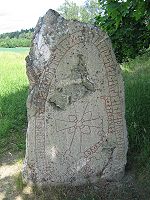
- × ikifastr × auk × austain × auk × suain × litu * raisa + staina þasa * at * austain faþur × sin × auk × bru × þasa karþu × auk × hauk þana ×
Old Norse transcription:
- Ingifastr ok Øystæinn ok Svæinn letu ræisa stæina þessa at Øystæin, faður sinn, ok bro þessa gærðu ok haug þenna.
English translation:
- Ingifastr and Eysteinn and Sveinn had these stones raised in memory of Eysteinn, their father, and made this bridge and this mound.
U 136
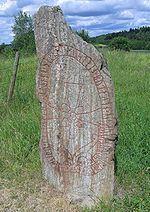
- × astriþr × la(t) + raisa × staina × þasa × [a]t austain × buta sin × is × suti × iursalir auk antaþis ub i × kirkum
Old Norse transcription:
- Æstriðr let ræisa stæina þessa at Øystæin, bonda sinn, es sotti IorsaliR ok ændaðis upp i Grikkium.
English translation:
- Ástríðr had these stones raised in memory of Eysteinn, her husbandman, who attacked Jerusalem and met his end up in Greece.
U 137
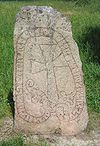
- * aystin * auk * astriþr * raistu * stina * aftir * kak * sun * sin *
Old Norse transcription:
- Øystæinn ok Æstriðr ræistu stæina æftiR Kag(?)/Gag(?), sun sinn.
English translation:
- Eysteinn and Ástríðr raised the stones in memory of Kagr(?)/Gagr(?), their son.
U 139
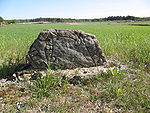
- ... ...sti ' ru... ... * hia(l)... ... hans
Old Norse transcription:
- ... [ri]sti ru[naR] ... hial[pi] ... hans
English translation:
- ... carved the runes ... may help ... his
U 151
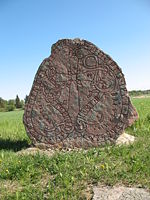
- × þurbiarn × uk × ikiþura × litu × raisa × ist[ai]n × þina × iftiR × ikul × faþur sin × uk × irinui × iftiR × buanta sin × uk afti(R) ---
Old Norse transcription:
- Þorbiorn ok Ingiþora letu ræisa stæin þenna æftiR Igul, faður sinn, ok Ærinvi æftiR boanda sinn ok æftiR ...
English translation:
- Þorbjôrn and Ingiþóra had this stone raised in memory of Ígull, their father; and Erinvé in memory of her husbandman and in memory of ...
Sources
- RundataRundataThe Scandinavian Runic-text Data Base is a project involving the creation and maintenance of a database of runic inscriptions. The project's goal is to comprehensively catalog runestones in a machine-readable way for future research...
- Inga och Estrid - en såpa för tusen år sedan: Människor, händelser och platser i Ingas och Estrids liv. A page at the Museum of Stockholm County.

